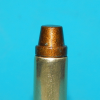vaalpens
Member
- Joined
- Aug 14, 2014
- Messages
- 2,618
I have just expanded my reloading horizon by getting into reloading for 38special and 357mag. There is a lot for me to learn, but with what I have seen so far, it looks like it should be easier than when I started reloading 357sig about one year ago to the day.
One of the skills I need to master is roll-crimping. When to apply it and how much to apply. Today for the first try I loaded some dummy bullets just to get the feeling of how the crimping could be applied. I am planning on doing seating and crimping in two separate steps, even though I will be using the same die. I also have the Lee FCD, I use the FCD for other cartridges, but I'm not sure yet if I will use it for 38/357 reloading.
Following are my first attempts at roll cimping. The first two is for the same bullet, but I wasn't sure where to apply the crimp since the crimp groove is so wide.


The next bullet has a very subtle print groove, and I can probably crimp a tiny bit lower, but again I'm not sure where the correct place is to crimp.

Please feel free to provide any comments regarding my crimping. Let me know if you think these are light, medium or heavy crimps. In some cases I will have to put in heavier crimps, so it will give me some baseline from where to adjust my crimping.
As always, any comments will be appreciated.
One of the skills I need to master is roll-crimping. When to apply it and how much to apply. Today for the first try I loaded some dummy bullets just to get the feeling of how the crimping could be applied. I am planning on doing seating and crimping in two separate steps, even though I will be using the same die. I also have the Lee FCD, I use the FCD for other cartridges, but I'm not sure yet if I will use it for 38/357 reloading.
Following are my first attempts at roll cimping. The first two is for the same bullet, but I wasn't sure where to apply the crimp since the crimp groove is so wide.
The next bullet has a very subtle print groove, and I can probably crimp a tiny bit lower, but again I'm not sure where the correct place is to crimp.
Please feel free to provide any comments regarding my crimping. Let me know if you think these are light, medium or heavy crimps. In some cases I will have to put in heavier crimps, so it will give me some baseline from where to adjust my crimping.
As always, any comments will be appreciated.







